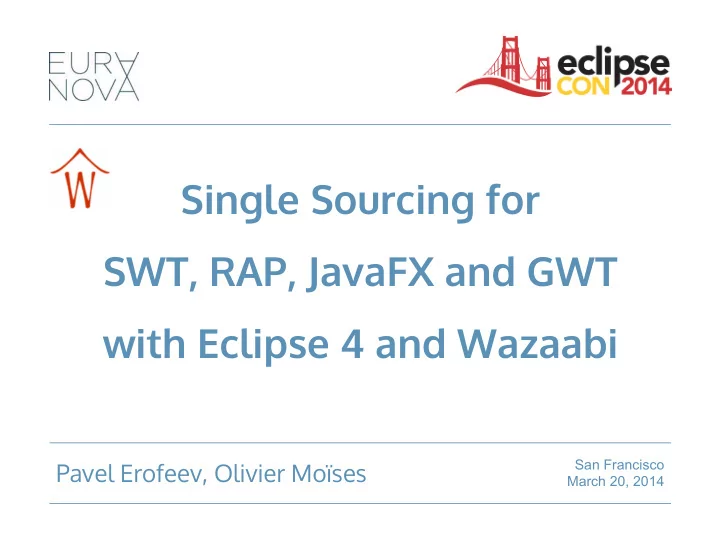

Single Sourcing for SWT, RAP, JavaFX and GWT with Eclipse 4 and Wazaabi San Francisco Pavel Erofeev, Olivier Moïses March 20, 2014
Speakers Olivier Moïses Wazaabi project lead Pavel Erofeev Wazaabi committer Software architect at EURA NOVA
Agenda ● Why Wazaabi ? ● What is Wazaabi ? ● Demo (creation of a form using Wazaabi tools) ● Integration with Eclipse 4 ● Demo (creation of an e4 RCP app with Wazaabi) ● Rendering engines for various platforms ● Demo (RAP, SWT, JavaFX, GWT) ● Roadmap
Why Wazaabi? To model the UI: ● Not to dilute UI structure in the code ● Compare versions ● Maintenance ● Documentation
What is Wazaabi ● Live UI model (EMF) ● Rendering engine ● Declarative data binding ● Tools to create models
UI Meta-Models ● Core model ○ common components (label, button, text field, check box, radio button, etc.) ○ common styles (color, font, border, simple layouts, etc.) ● Specific platform models ○ layouts ○ specific components ○ specific styles
Rendering Engine UI models can be rendered live on various platforms: ● SWT - full support, including Eclipse Forms UI ● RAP - few restrictions ● JavaFX - prototype ● GWT - prototype
Data Binding & Event Handling ● Properties of UI components can be bound to fields in business model ○ Declarative ○ Live ● Event Handling ○ By default in Java ○ Can be in any JVM language (Groovy, Scala, Clojure) ○ And even in JavaScript
Wazaabi Tools ● Tree Editor (ready to be used) ● DSL (proprietary versions exist) ● WYSIWYG editor (in progress) Why do we need special tools? ● Reduce the distance between design and runtime (immediate rendering of the model) ● Rapid prototyping (together with end user) ● Reduce the time: 1 sec per form (using automatic creation of draft UI based on domain model)
Wazaabi Tools
When to use Wazaabi? ● Use Wazaabi ○ To create a lot of forms ○ Write once the UI, run on various platforms ○ When your developers are not high skilled ● Do not use Wazaabi ○ To create complex UIs that require all power of a UI framework (extend Wazaabi instead)
Demo Creation of a form using Wazaabi tools
Integration with E4 ● Continuation of live workbench model ● Integration with e4 mechanism
Demo Creation of an e4 app with a Wazaabi form
Rendering Engines ● SWT fully supported ● JavaFX, currently in prototype, can be fully supported (looking for sponsors…) ● GWT, currently in prototype, need some refactoring (reflexion ….)
Demo Single form rendered with SWT, JavaFX, GWT
Roadmap ● Release in Eclipse ● WYSIWYG editor ● Android rendering engine ● Vaadin rendering engine ● Improvement of tools ● RAP based editor ● Documentation ● JSON domain models
Try it! www.eclipse.org/wazaabi
Questions
Recommend
More recommend